The Dynamic Effects of Isosteviol on Insulin Secretion and Its Inability to Counteract the Impaired β-Cell Function during Gluco-, Lipo-, and Aminoacidotoxicity: Studies In Vitro
Abstract
:1. Introduction
2. Materials and Methods
2.1. Materials
2.2. Isolation of Islets
2.3. Perifusion of Islets
2.4. Culture of INS-1E Cells
2.5. Viability of INS-1E Cells
2.6. Insulin Secretion from INS-1E Cells
2.7. Insulin Assay
3. Statistical Analysis
4. Results
4.1. Effects of ISV on the Dynamic of Insulin Release from Perifused Mouse Islets
4.2. Impact of Gluco-, Lipo-, and Aminoacidotoxicity on the Viability of INS-1E Cells
4.2.1. Glucotoxicity
4.2.2. Lipotoxicity
4.2.3. Aminoacidotoxicity
4.3. Impact of Gluco-, Lipo-, and Aminoacidotoxicity on Insulin Secretion of INS-1E Cells
4.3.1. Glucotoxicity
4.3.2. Lipotoxicity
4.3.3. Aminoacidotoxicity
5. Discussion
6. Conclusions
Acknowledgements
Author Contributions
Conflicts of Interest
References
- Lebovitz, H.E. Type 2 diabetes: An overview. Clin. Chem. 1999, 45, 1339–1345. [Google Scholar] [PubMed]
- Chen, C.; Cohrs, C.M.; Stertmann, J.; Bozsak, R.; Speier, S. Human beta cell mass and function in diabetes: Recent advances in knowledge and technologies to understand disease pathogenesis. Mol. Metab. 2017, 6, 943–957. [Google Scholar] [CrossRef] [PubMed]
- Engelbrechtsen, L.; Andersson, E.; Roepstorff, S.; Hansen, T.; Vestergaard, H. Pharmacogenetics and individual responses to treatment of hyperglycemia in type 2 diabetes. Pharmacogenet. Genom. 2015, 25, 475–484. [Google Scholar] [CrossRef] [PubMed]
- Høiriis Nielsen, J.; Svensson, C.; Douglas Galsgaard, E.; Møldrup, A.; Billestrup, N. Beta cell proliferation and growth factors. J. Mol. Med. 1999, 77, 62–66. [Google Scholar] [CrossRef]
- Chen, F.; Sha, M.; Wang, Y.; Wu, T.; Shan, W.; Liu, J.; Zhou, W.; Zhu, Y.; Sun, Y.; Shi, Y.; et al. Transcription factor ets-1 links glucotoxicity to pancreatic beta cell dysfunction through inhibiting pdx-1 expression in rodent models. Diabetologia 2016, 59, 316–324. [Google Scholar] [CrossRef] [PubMed]
- Wali, J.A.; Rondas, D.; McKenzie, M.D.; Zhao, Y.; Elkerbout, L.; Fynch, S.; Gurzov, E.N.; Akira, S.; Mathieu, C.; Kay, T.W.; et al. The proapoptotic bh3-only proteins bim and puma are downstream of endoplasmic reticulum and mitochondrial oxidative stress in pancreatic islets in response to glucotoxicity. Cell Death Dis. 2014, 5, e1124. [Google Scholar] [CrossRef] [PubMed]
- Fu, J.; Cui, Q.; Yang, B.; Hou, Y.; Wang, H.; Xu, Y.; Wang, D.; Zhang, Q.; Pi, J. The impairment of glucose-stimulated insulin secretion in pancreatic beta-cells caused by prolonged glucotoxicity and lipotoxicity is associated with elevated adaptive antioxidant response. Food Chem. Toxicol. 2017, 100, 161–167. [Google Scholar] [CrossRef] [PubMed]
- Cernea, S.; Dobreanu, M. Diabetes and beta cell function: From mechanisms to evaluation and clinical implications. Biochem. Med. (Zagreb) 2013, 23, 266–280. [Google Scholar] [CrossRef] [PubMed]
- Olson, L.K.; Redmon, J.B.; Towle, H.C.; Robertson, R.P. Chronic exposure of hit cells to high glucose concentrations paradoxically decreases insulin gene transcription and alters binding of insulin gene regulatory protein. J. Clin. Investig. 1993, 92, 514–519. [Google Scholar] [CrossRef] [PubMed]
- Olson, L.K.; Sharma, A.; Peshavaria, M.; Wright, C.V.; Towle, H.C.; Rodertson, R.P.; Stein, R. Reduction of insulin gene transcription in hit-t15 beta cells chronically exposed to a supraphysiologic glucose concentration is associated with loss of stf-1 transcription factor expression. PNAS 1995, 92, 9127–9131. [Google Scholar] [CrossRef] [PubMed]
- Harmon, J.S.; Stein, R.; Robertson, R.P. Oxidative stress-mediated, post-translational loss of mafa protein as a contributing mechanism to loss of insulin gene expression in glucotoxic beta cells. J. Biol. Chem. 2005, 280, 11107–11113. [Google Scholar] [CrossRef] [PubMed]
- Poitout, V.; Olson, L.K.; Robertson, R.P. Chronic exposure of betatc-6 cells to supraphysiologic concentrations of glucose decreases binding of the ripe3b1 insulin gene transcription activator. J. Clin. Investig. 1996, 97, 1041–1046. [Google Scholar] [CrossRef] [PubMed]
- Kowluru, A. Inappropriate movement of rac1 contributes to glucotoxicity of the islet beta-cell. Cell Cycle 2017, 16, 1387–1388. [Google Scholar] [CrossRef] [PubMed]
- Cnop, M.; Abdulkarim, B.; Bottu, G.; Cunha, D.A.; Igoillo-Esteve, M.; Masini, M.; Turatsinze, J.V.; Griebel, T.; Villate, O.; Santin, I.; et al. Rna sequencing identifies dysregulation of the human pancreatic islet transcriptome by the saturated fatty acid palmitate. Diabetes 2014, 63, 1978–1993. [Google Scholar] [CrossRef] [PubMed]
- Amery, C.M.; Nattrass, M. Fatty acids and insulin secretion. Diabetes Obes. Metab. 2000, 2, 213–221. [Google Scholar] [CrossRef] [PubMed]
- El-Assaad, W.; Buteau, J.; Peyot, M.L.; Nolan, C.; Roduit, R.; Hardy, S.; Joly, E.; Dbaibo, G.; Rosenberg, L.; Prentki, M. Saturated fatty acids synergize with elevated glucose to cause pancreatic beta-cell death. Endocrinology 2003, 144, 4154–4163. [Google Scholar] [CrossRef] [PubMed]
- Lupi, R.; Dotta, F.; Marselli, L.; Del Guerra, S.; Masini, M.; Santangelo, C.; Patane, G.; Boggi, U.; Piro, S.; Anello, M.; et al. Prolonged exposure to free fatty acids has cytostatic and pro-apoptotic effects on human pancreatic islets: Evidence that beta-cell death is caspase mediated, partially dependent on ceramide pathway, and bcl-2 regulated. Diabetes 2002, 51, 1437–1442. [Google Scholar] [CrossRef] [PubMed]
- Lee, S.H.; Cunha, D.; Piermarocchi, C.; Paternostro, G.; Pinkerton, A.; Ladriere, L.; Marchetti, P.; Eizirik, D.L.; Cnop, M.; Levine, F. High-throughput screening and bioinformatic analysis to ascertain compounds that prevent saturated fatty acid-induced beta-cell apoptosis. Biochem. Pharmacol. 2017, 138, 140–149. [Google Scholar] [CrossRef] [PubMed]
- Cunha, D.A.; Hekerman, P.; Ladriere, L.; Bazarra-Castro, A.; Ortis, F.; Wakeham, M.C.; Moore, F.; Rasschaert, J.; Cardozo, A.K.; Bellomo, E.; et al. Initiation and execution of lipotoxic er stress in pancreatic beta-cells. J. Cell Sci. 2008, 121, 2308–2318. [Google Scholar] [CrossRef] [PubMed]
- Natalicchio, A.; Tortosa, F.; Labarbuta, R.; Biondi, G.; Marrano, N.; Carchia, E.; Leonardini, A.; Cignarelli, A.; Bugliani, M.; Marchetti, P.; et al. The p66Shc redox adaptor protein is induced by saturated fatty acids and mediates lipotoxicity-induced apoptosis in pancreatic beta cells. Diabetologia 2015, 58, 1260–1271. [Google Scholar] [CrossRef] [PubMed]
- Carlsson, C.; Borg, L.A.; Welsh, N. Sodium palmitate induces partial mitochondrial uncoupling and reactive oxygen species in rat pancreatic islets in vitro. Endocrinology 1999, 140, 3422–3428. [Google Scholar] [CrossRef] [PubMed]
- Cunha, D.A.; Igoillo-Esteve, M.; Gurzov, E.N.; Germano, C.M.; Naamane, N.; Marhfour, I.; Fukaya, M.; Vanderwinden, J.M.; Gysemans, C.; Mathieu, C.; et al. Death protein 5 and p53-upregulated modulator of apoptosis mediate the endoplasmic reticulum stress-mitochondrial dialog triggering lipotoxic rodent and human beta-cell apoptosis. Diabetes 2012, 61, 2763–2775. [Google Scholar] [CrossRef] [PubMed]
- Barlow, J.; Jensen, V.H.; Jastroch, M.; Affourtit, C. Palmitate-induced impairment of glucose-stimulated insulin secretion precedes mitochondrial dysfunction in mouse pancreatic islets. Biochem. J. 2016, 473, 487–496. [Google Scholar] [CrossRef] [PubMed]
- Ciregia, F.; Bugliani, M.; Ronci, M.; Giusti, L.; Boldrini, C.; Mazzoni, M.R.; Mossuto, S.; Grano, F.; Cnop, M.; Marselli, L.; et al. Palmitate-induced lipotoxicity alters acetylation of multiple proteins in clonal beta cells and human pancreatic islets. Sci. Rep. 2017, 7, 13445. [Google Scholar] [CrossRef] [PubMed]
- Hong, J.; Jeppesen, P.B.; Hermansen, K. Effects of elevated fatty acid and glucose concentrations on pancreatic islet function in vitro. Diabetes Obes. Metab. 2009, 11, 397–404. [Google Scholar] [PubMed]
- Liu, Z.; Jeppesen, P.B.; Gregersen, S.; Larsen, L.B.; Hermansen, K. Chronic exposure to leucine in vitro induces beta-cell dysfunction in ins-1e cells and mouse islets. J. Endocrinol. 2012, 215, 79–88. [Google Scholar] [CrossRef] [PubMed]
- Liu, Z.; Luo, Y.; Jeppesen, P.B.; Gregersen, S.; Hermansen, K. Amino acid-induced gene expression profiling in clonal beta-cell line ins-1e cells. Diabetes Metab. Res. Rev. 2011, 27, 120–176. [Google Scholar] [CrossRef] [PubMed]
- Liu, Z.; Jeppesen, P.B.; Gregersen, S.; Bach Larsen, L.; Hermansen, K. Chronic exposure to proline causes aminoacidotoxicity and impaired beta-cell function: Studies in vitro. Rev. Diabet. Stud. 2016, 13, 66–78. [Google Scholar] [CrossRef] [PubMed]
- Schulze, M.B.; Manson, J.E.; Willett, W.C.; Hu, F.B. Processed meat intake and incidence of type 2 diabetes in younger and middle-aged women. Diabetologia 2003, 46, 1465–1473. [Google Scholar] [CrossRef] [PubMed]
- Newgard, C.B.; An, J.; Bain, J.R.; Muehlbauer, M.J.; Stevens, R.D.; Lien, L.F.; Haqq, A.M.; Shah, S.H.; Arlotto, M.; Slentz, C.A.; et al. A branched-chain amino acid-related metabolic signature that differentiates obese and lean humans and contributes to insulin resistance. Cell Metab. 2009, 9, 311–326. [Google Scholar] [CrossRef] [PubMed]
- Tai, E.S.; Tan, M.L.; Stevens, R.D.; Low, Y.L.; Muehlbauer, M.J.; Goh, D.L.; Ilkayeva, O.R.; Wenner, B.R.; Bain, J.R.; Lee, J.J.; et al. Insulin resistance is associated with a metabolic profile of altered protein metabolism in chinese and asian-indian men. Diabetologia 2010, 53, 757–767. [Google Scholar] [CrossRef] [PubMed]
- Testai, L.; Strobykina, I.; Semenov, V.V.; Semenova, M.; Pozzo, E.D.; Martelli, A.; Citi, V.; Martini, C.; Breschi, M.C.; Kataev, V.E.; et al. Mitochondriotropic and cardioprotective effects of triphenylphosphonium-conjugated derivatives of the diterpenoid isosteviol. Int. J. Mol. Sci. 2017, 18, 2060. [Google Scholar] [CrossRef] [PubMed]
- Nordentoft, I.; Jeppesen, P.B.; Hong, J.; Abudula, R.; Hermansen, K. Isosteviol increases insulin sensitivity and changes gene expression of key insulin regulatory genes and transcription factors in islets of the diabetic kkay mouse. Diabetes Obes. Metab. 2008, 10, 939–949. [Google Scholar] [CrossRef] [PubMed]
- Bertram, H.C.; Jeppesen, P.B.; Hermansen, K. An NMR-based metabonomic investigation on effects of supplementation with isosteviol or soy protein to diabetic kkay mice. Diabetes Obes. Metab. 2009, 11, 992–995. [Google Scholar] [CrossRef] [PubMed]
- Chen, X.; Hermansen, K.; Xiao, J.; Bystrup, S.K.; O’Driscoll, L.; Jeppesen, P.B. Isosteviol has beneficial effects on palmitate-induced alpha-cell dysfunction and gene expression. PLoS ONE 2012, 7, e34361. [Google Scholar]
- Lacy, P.E.; Kostianovsky, M. Method for the isolation of intact islets of langerhans from the rat pancreas. Diabetes 1967, 16, 35–39. [Google Scholar] [CrossRef] [PubMed]
- Gregersen, S.; Thomsen, J.L.; Brock, B.; Hermansen, K. Endothelin-1 stimulates insulin secretion by direct action on the islets of langerhans in mice. Diabetologia 1996, 39, 1030–1035. [Google Scholar] [CrossRef] [PubMed]
- Merglen, A.; Theander, S.; Rubi, B.; Chaffard, G.; Wollheim, C.B.; Maechler, P. Glucose sensitivity and metabolism-secretion coupling studied during two-year continuous culture in INS-1E insulinoma cells. Endocrinology 2004, 145, 667–678. [Google Scholar] [CrossRef] [PubMed]
- Chatsudthipong, V.; Muanprasat, C. Stevioside and related compounds: Therapeutic benefits beyond sweetness. Pharmacol. Ther. 2009, 121, 41–54. [Google Scholar] [CrossRef] [PubMed]
- Jeppesen, P.B.; Gregersen, S.; Poulsen, C.R.; Hermansen, K. Stevioside acts directly on pancreatic beta cells to secrete insulin: Actions independent of cyclic adenosine monophosphate and adenosine triphosphate-sensitive K+-channel activity. Metabolism 2000, 49, 208–214. [Google Scholar] [CrossRef]
- Jeppesen, P.B.; Gregersen, S.; Alstrup, K.K.; Hermansen, K. Stevioside induces antihyperglycaemic, insulinotropic and glucagonostatic effects in vivo: Studies in the diabetic goto-kakizaki (GK) rats. Phytomedicine 2002, 9, 9–14. [Google Scholar] [CrossRef] [PubMed]
- Jeppesen, P.B.; Gregersen, S.; Rolfsen, S.E.; Jepsen, M.; Colombo, M.; Agger, A.; Xiao, J.; Kruhoffer, M.; Orntoft, T.; Hermansen, K. Antihyperglycemic and blood pressure-reducing effects of stevioside in the diabetic goto-kakizaki rat. Metabolism 2003, 52, 372–378. [Google Scholar] [CrossRef] [PubMed]
- Jeppesen, P.B.; Dyrskog, S.E.; Agger, A.; Gregersen, S.; Colombo, M.; Xiao, J.; Hermansen, K. Can stevioside in combination with a soy-based dietary supplement be a new useful treatment of type 2 diabetes? An in vivo study in the diabetic goto-kakizaki rat.Rev. Diabetes Stud. 2006, 3, 189–199. [Google Scholar] [CrossRef] [PubMed]
- Abudula, R.; Jeppesen, P.B.; Rolfsen, S.E.; Xiao, J.; Hermansen, K. Rebaudioside a potently stimulates insulin secretion from isolated mouse islets: Studies on the dose-, glucose-, and calcium-dependency. Metabolism 2004, 53, 1378–1381. [Google Scholar] [CrossRef] [PubMed]
- Evans Kreider, K.; Pereira, K.; Padilla, B.I. Practical approaches to diagnosing, treating and preventing hypoglycemia in diabetes. Diabetes Ther. 2017, 8, 1427–1435. [Google Scholar] [CrossRef] [PubMed]
- Ortiz, M.R. Hypoglycemia in diabetes. Nurs. Clin. N. Am. 2017, 52, 565–574. [Google Scholar] [CrossRef] [PubMed]
- Thrasher, J. Pharmacologic management of type 2 diabetes mellitus: Available therapies. Am. J. Cardiol. 2017, 120, S4–S16. [Google Scholar] [CrossRef] [PubMed]
- Vennekens, R.; Mesuere, M.; Philippaert, K. Trpm5 in the battle against diabetes and obesity. Acta Physiol. 2017. [Google Scholar] [CrossRef] [PubMed]
- Kim, M.S.; Pinto, S.M.; Getnet, D.; Nirujogi, R.S.; Manda, S.S.; Chaerkady, R.; Madugundu, A.K.; Kelkar, D.S.; Isserlin, R.; Jain, S.; et al. A draft map of the human proteome. Nature 2014, 509, 575–581. [Google Scholar] [CrossRef] [PubMed]
- Fonfria, E.; Murdock, P.R.; Cusdin, F.S.; Benham, C.D.; Kelsell, R.E.; McNulty, S. Tissue distribution profiles of the human trpm cation channel family. J. Recept. Signal Transduct. Res. 2006, 26, 159–178. [Google Scholar] [CrossRef] [PubMed]
- Philippaert, K.; Pironet, A.; Mesuere, M.; Sones, W.; Vermeiren, L.; Kerselaers, S.; Pinto, S.; Segal, A.; Antoine, N.; Gysemans, C.; et al. Steviol glycosides enhance pancreatic beta-cell function and taste sensation by potentiation of trpm5 channel activity. Nat. Commun. 2017, 8, 14733. [Google Scholar] [CrossRef] [PubMed]
- Buteau, J.; El-Assaad, W.; Rhodes, C.J.; Rosenberg, L.; Joly, E.; Prentki, M. Glucagon-like peptide-1 prevents beta cell glucolipotoxicity. Diabetologia 2004, 47, 806–815. [Google Scholar] [PubMed]
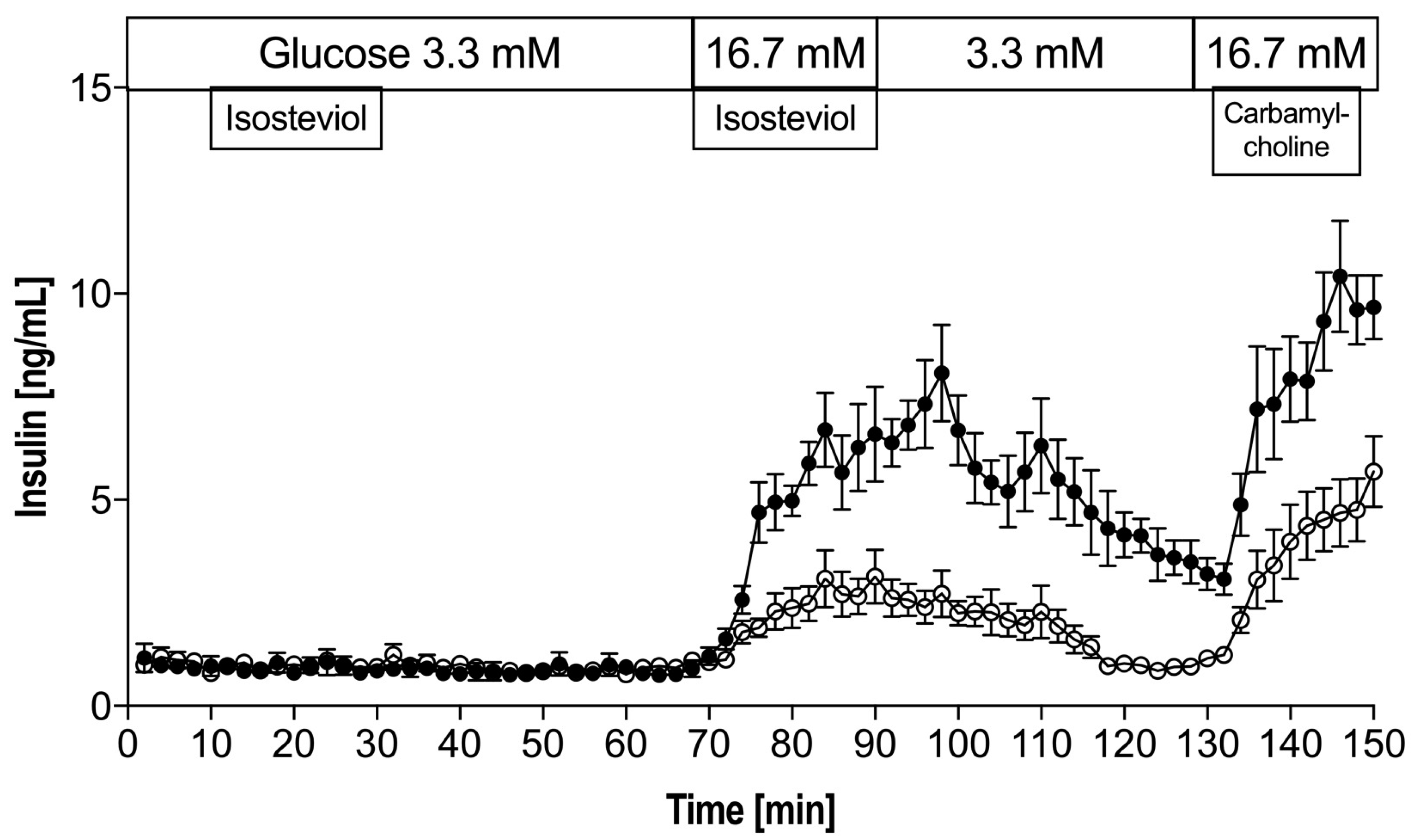
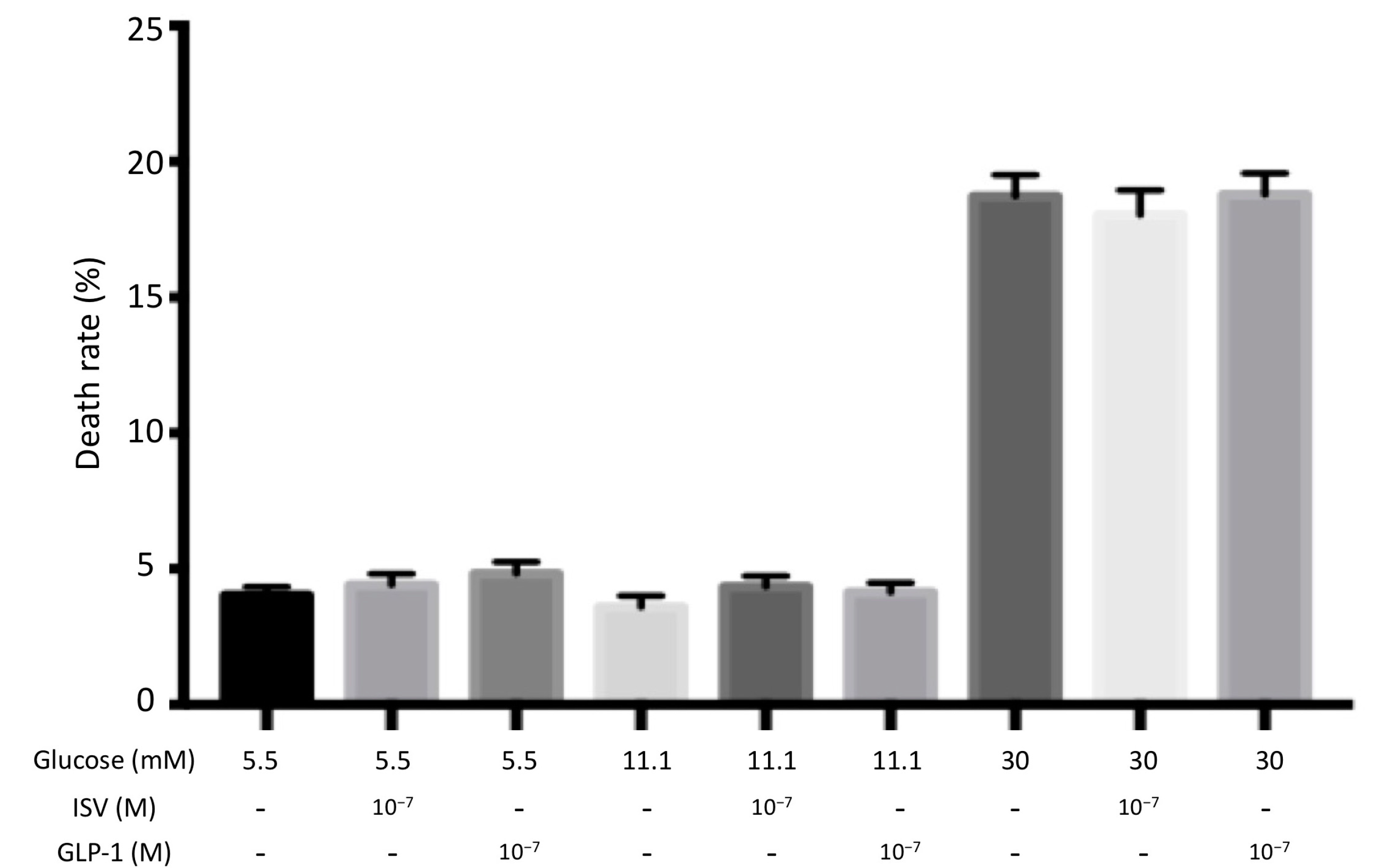
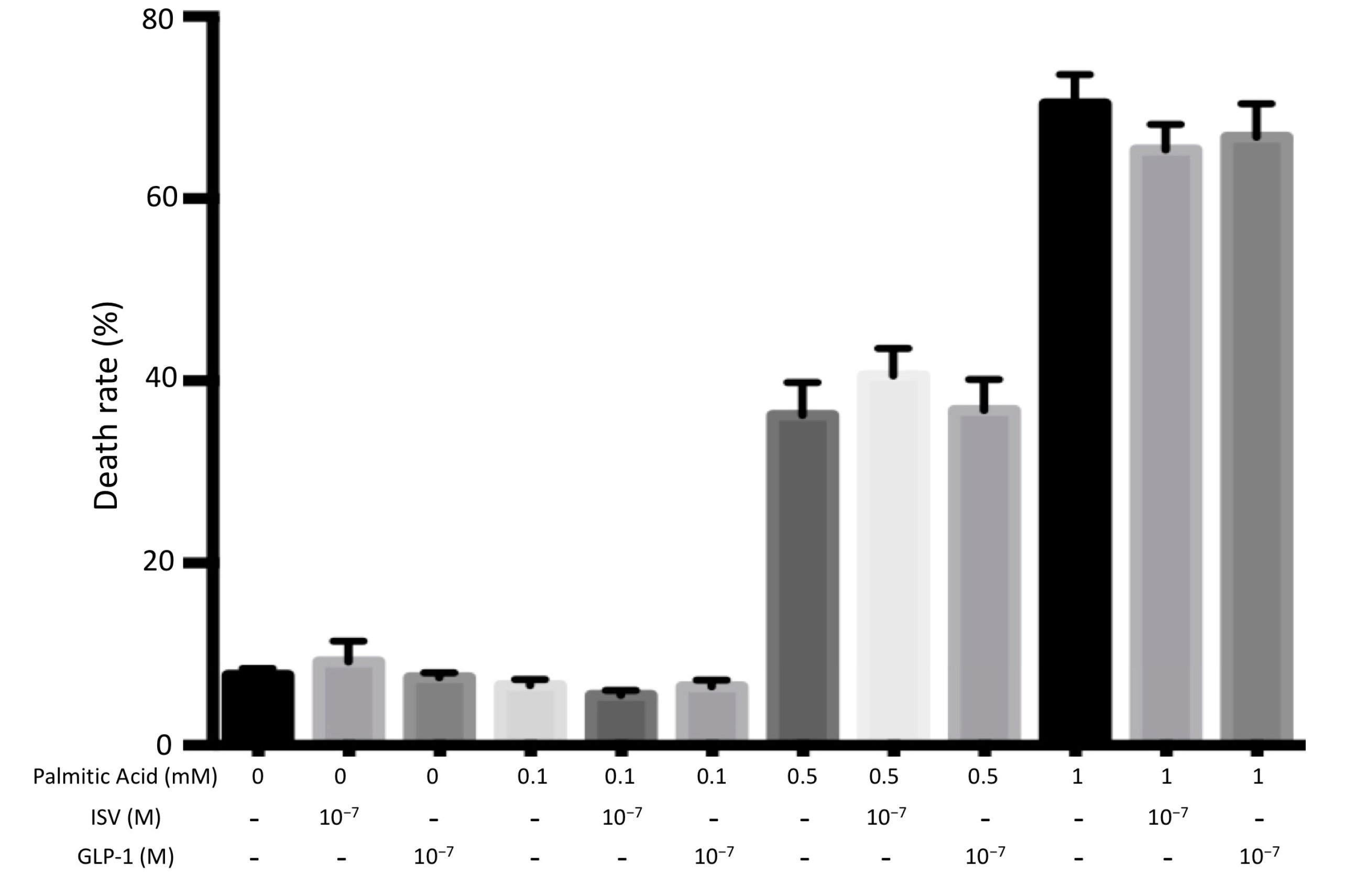
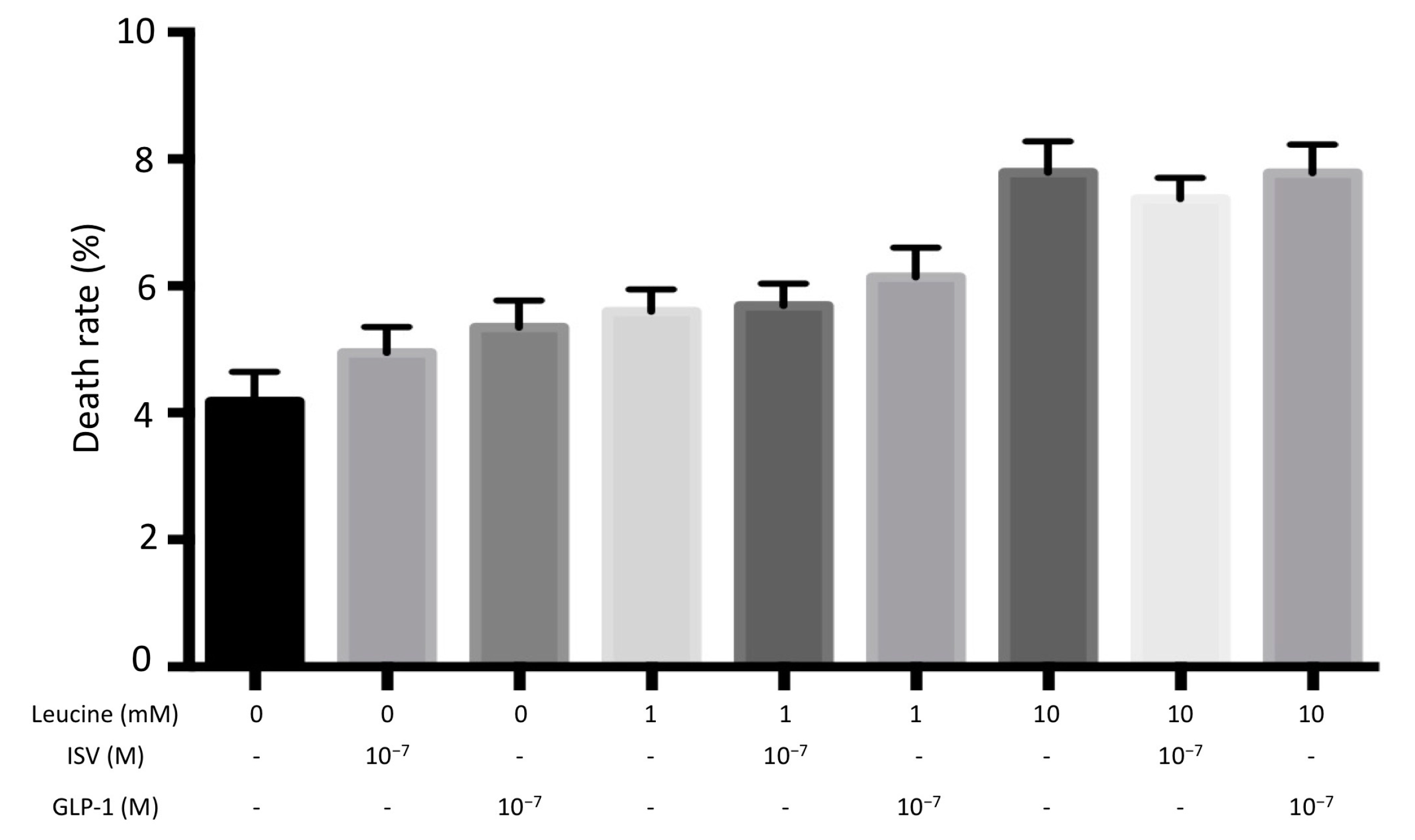

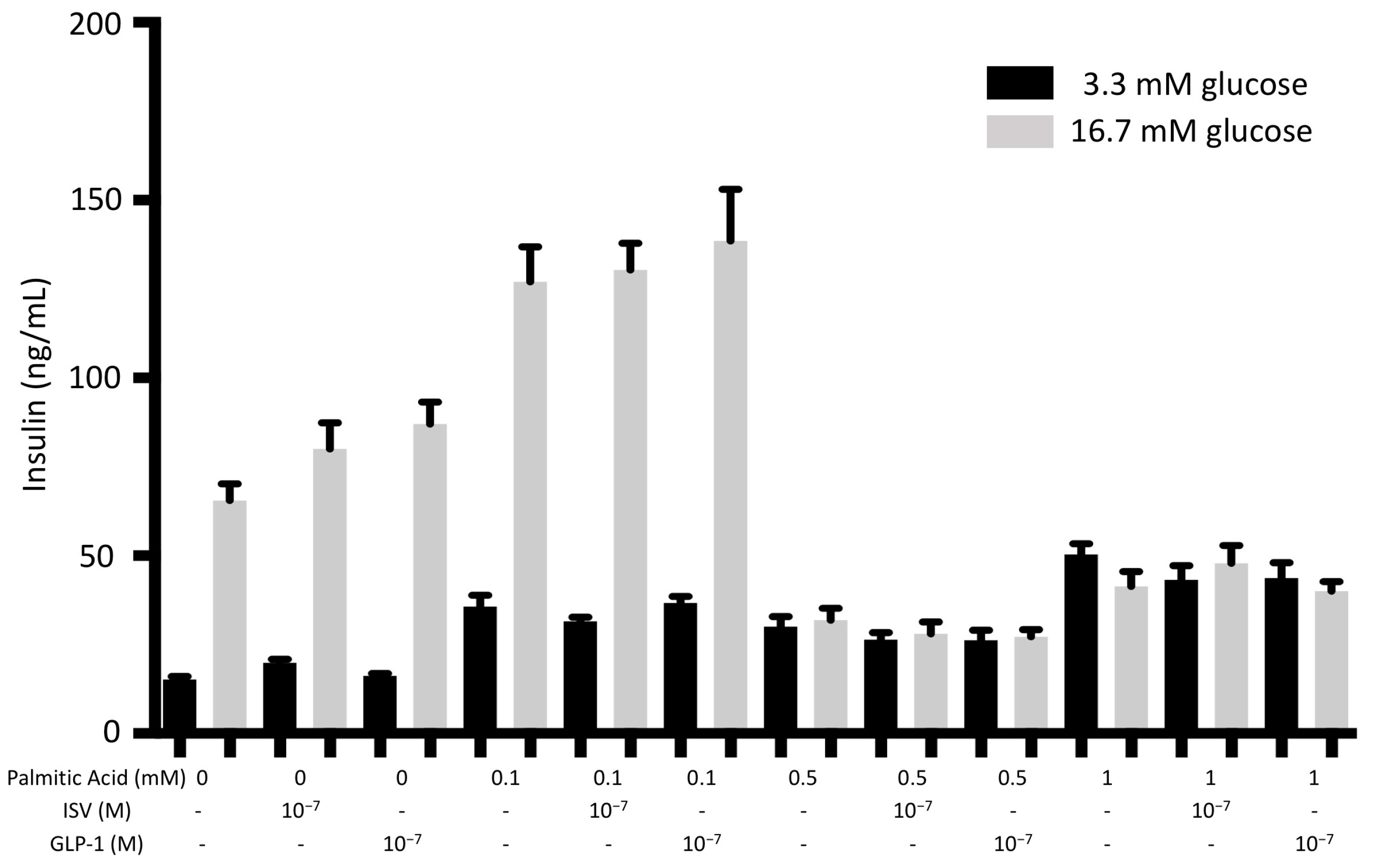
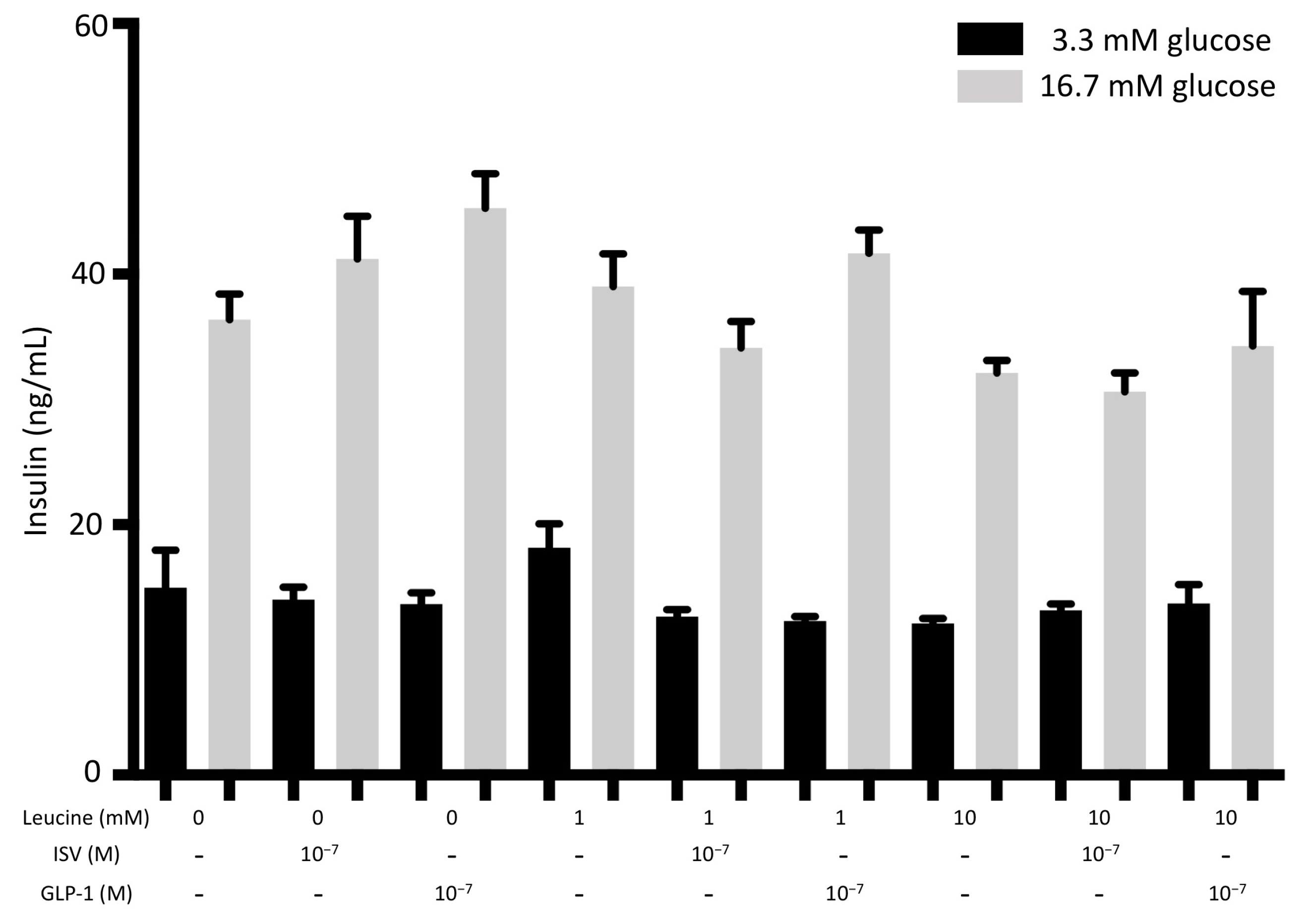
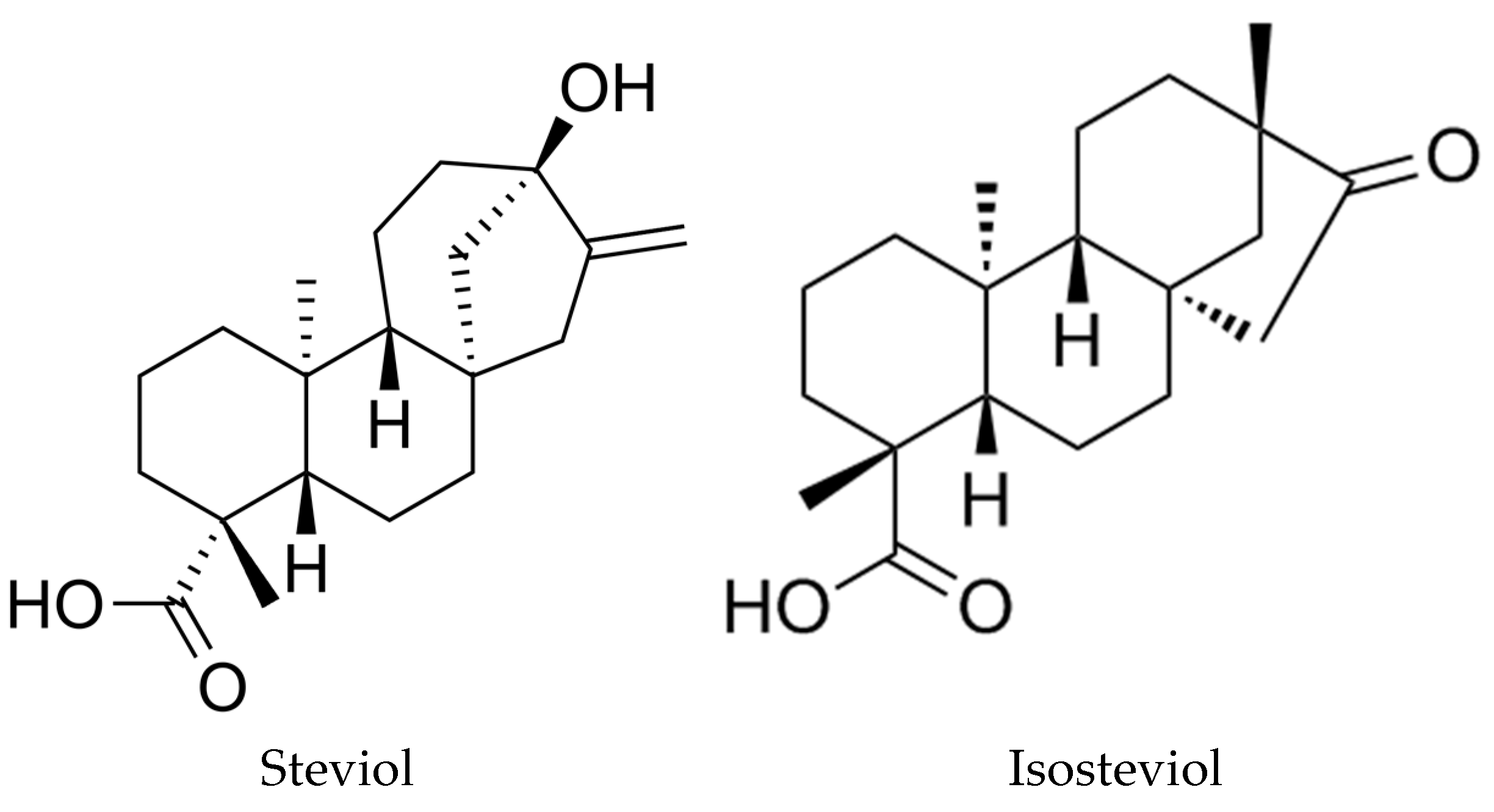
© 2018 by the authors. Licensee MDPI, Basel, Switzerland. This article is an open access article distributed under the terms and conditions of the Creative Commons Attribution (CC BY) license (http://creativecommons.org/licenses/by/4.0/).
Share and Cite
Gu, W.; Rebsdorf, A.; Hermansen, K.; Gregersen, S.; Jeppesen, P.B. The Dynamic Effects of Isosteviol on Insulin Secretion and Its Inability to Counteract the Impaired β-Cell Function during Gluco-, Lipo-, and Aminoacidotoxicity: Studies In Vitro. Nutrients 2018, 10, 127. https://doi.org/10.3390/nu10020127
Gu W, Rebsdorf A, Hermansen K, Gregersen S, Jeppesen PB. The Dynamic Effects of Isosteviol on Insulin Secretion and Its Inability to Counteract the Impaired β-Cell Function during Gluco-, Lipo-, and Aminoacidotoxicity: Studies In Vitro. Nutrients. 2018; 10(2):127. https://doi.org/10.3390/nu10020127
Chicago/Turabian StyleGu, Wenqian, Andreas Rebsdorf, Kjeld Hermansen, Søren Gregersen, and Per Bendix Jeppesen. 2018. "The Dynamic Effects of Isosteviol on Insulin Secretion and Its Inability to Counteract the Impaired β-Cell Function during Gluco-, Lipo-, and Aminoacidotoxicity: Studies In Vitro" Nutrients 10, no. 2: 127. https://doi.org/10.3390/nu10020127
APA StyleGu, W., Rebsdorf, A., Hermansen, K., Gregersen, S., & Jeppesen, P. B. (2018). The Dynamic Effects of Isosteviol on Insulin Secretion and Its Inability to Counteract the Impaired β-Cell Function during Gluco-, Lipo-, and Aminoacidotoxicity: Studies In Vitro. Nutrients, 10(2), 127. https://doi.org/10.3390/nu10020127




